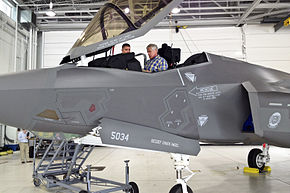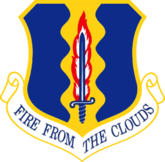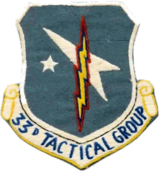| 33d Operations Group | |
|---|---|
 | |
| Active | 1941–1945; 1946–1952; 1955–1957; 1991–present |
| Country | |
| Branch | |
| Role | Fighter operations and training |
| Part of | 33d Fighter Wing |
| Garrison/HQ | Eglin Air Force Base |
| Nickname(s) | Nomads |
| Motto(s) | Fire From the Clouds |
| Engagements | Mediterranean Theater of Operations China Burma India Theater Vietnam War |
| Decorations | Distinguished Unit Citation Air Force Outstanding Unit Award |
| Commanders | |
| Notable commanders | Col. Elwood R. Quesada Col. William W. Momyer Col. Willard W. Millikan |
| Insignia | |
| 33d Operations Group emblem (approved 21 February 1942)[1][note 1] |  |
| Patch with 33d Tactical Group emblem |  |
The 33d Operations Group is the flying component of the 33d Fighter Wing, assigned to Air Education and Training Command of the United States Air Force. The group is stationed at Eglin Air Force Base, Florida.
The group was first activated in January 1941 as the 33d Pursuit Group and began training in fighter operations at Mitchel Field, New York. Following the attack on Pearl Harbor the group moved to Philadelphia, where it assumed an air defense role while training for combat. After being redesignated the 33d Fighter Group, it moved to the Mediterranean Theater of Operations in November 1942 as part of Operation Torch, the invasion of North Africa, flying its planes to its first base in Morocco from the aircraft carrier USS Chenango of the United States Navy. The group served in North Africa and Italy until February 1944, earning a Distinguished Unit Citation in January 1943 for its defense of its base from attacks by German and Italian aircraft.
In 1944, the group departed Italy for the China-Burma-India Theater, leaving its Curtiss P-40 Warhawks behind for Lockheed P-38 Lightnings and Republic P-47 Thunderbolts. It continued combat operations until the surrender of Japan. In November 1945, it returned to the United States and was inactivated when it arrived at the Army's port of embarkation.[note 2]
The group was activated as part of the Occupation Forces at Neubiberg Air Base, Germany, where it took over the personnel and equipment of the 357th Fighter Group, which was inactivated and transferred to the National Guard. In July 1947, its personnel became the cadre for the 86th Composite Group, while the group made two moves without personnel or equipment before arriving at Roswell Army Air Field, where it equipped with North American P-51 Mustangs and became part of the fledgling Strategic Air Command. A year later, it received its first jet aircraft, the Republic F-84 Thunderjet. In 1948. the group moved to Otis Air Force Base, Massachusetts, where it assumed an air defense role, first under Continental Air Command, then under Air Defense Command (ADC) as the 33d Fighter-Interceptor Group. It was inactivated in February 1952 when ADC reorganized its forces on a geographic basis.
ADC activated the group, once more the 33d Fighter Group, at Otis in August 1955 as part of Project Arrow, a program to replace ADC's Air Defense Groups with fighter groups with distinguished combat records in World War II. As Otis expanded to add the airborne early warning and control mission the following year, the group's support units were transferred to the newly reactivated 33d Fighter Wing. In 1957, the group and wing were inactivated and the group's flying squadrons were transferred to the Boston Air Defense Sector
As the United States Air Force implemented the Objective wing reorganization in 1991, the 33d, now designated the 33d Operations Group, was activated to command the 33d Fighter Wing's operational units. It flew the McDonnell Douglas F-15 Eagle until 2009, when it began the transition to the Lockheed Martin F-35 Lightning II Joint Strike Fighter.
- ^ Maurer, Combat Units, pp. 86–87
Cite error: There are <ref group=note> tags on this page, but the references will not show without a {{reflist|group=note}} template (see the help page).